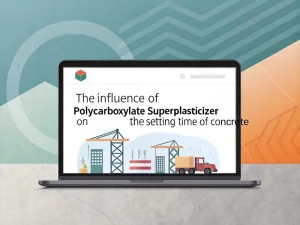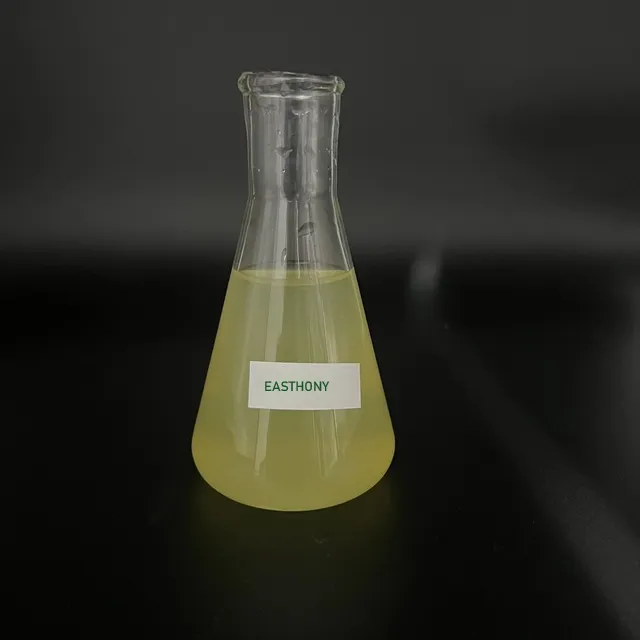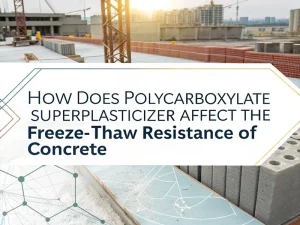
The Influence Of Polycarboxylate Superplasticizer On The Setting Time Of Concrete
Blog The influence of pol
Blog

Abstract: In the field of construction engineering today, the quality and performance of concrete play a crucial role in ensuring the safety, durability, and economy of various engineering projects.
As a modern high-performance admixture, polycarboxylate superplasticizer has become a key driving force for the development of concrete technology. It is widely used in many infrastructure construction projects such as roads, bridges, dams, tunnels, and high-rise buildings, significantly improving the comprehensive performance of concrete and promoting the progress of the construction industry.
This type of polycarboxylate superplasticizer mainly polymerizes acrylic acid or methacrylic acid as the main chain segment and grafts polyether side chains of different lengths through chemical bonding. Polyether side chains are usually polymerized from monomers such as ethylene oxide or propylene oxide, and their length and structure can be designed according to specific needs.
This structure endows water-reducing agents with unique properties, and longer polyether side chains can provide a more significant steric hindrance effect, effectively preventing the agglomeration of cement particles and thereby improving the fluidity and dispersibility of concrete.
The functional groups, such as carboxyl groups on the main chain of acrylic acid or methyl acrylic acid, are adsorbed on the surface of cement particles through electrostatic interactions, enhancing the interaction between water-reducing agents and cement and further optimizing the workability of concrete.
Another standard structure of polycarboxylate superplasticizer is based on maleic anhydride, which introduces side chains of different lengths through polymerization reactions. The maleic anhydride group has high reactivity and can copolymerize with various monomers to form water-reducing agent molecules with varying performance characteristics.
This type of water reducer has a certain degree of flexibility in its molecular structure, and the changes in its side chains can adjust the steric hindrance and adsorption properties of the water reducer, making it effective in different concrete application scenarios.
For example, in some projects that require high early strength of concrete, by adjusting the structure of maleic anhydride side chains, effective control of concrete setting time and early strength development can be achieved.
The molecular structure of polycarboxylate superplasticizer directly determines its performance. Different structures of water-reducing agents have differences in dispersibility, slump retention, water reduction rate, and adaptability to cement. By designing the molecular structure reasonably, polycarboxylate superplasticizers with specific properties can be customized according to particular engineering needs to meet diverse construction engineering requirements.
For example, in concrete engineering constructed in high-temperature environments, polycarboxylate superplasticizer structures with high collapse resistance and appropriate retarding effects can be selected to ensure the workability of concrete during transportation and pouring.
In bridge engineering that requires exceptionally high concrete strength, the structure of water reducing agents can be optimized to improve their water reduction rate and reinforcement effect, thereby obtaining high-strength concrete.
Before the emergence of polycarboxylate superplasticizers, commonly used additives in construction engineering included lignosulfonates, naphthalene sulfonate formaldehyde condensates, melamine formaldehyde condensates, acetone sulfonate formaldehyde condensates, and amino sulfonate formaldehyde condensates.
These traditional additives can improve certain properties of concrete to a certain extent, but they also have many shortcomings.
Lignin sulfonate additives have a relatively low water reduction rate, generally around 10% -15%, and have a strong retarding effect, which can easily lead to long concrete setting time and affect construction progress;
Although the water reduction rate of naphthalene sulfonate formaldehyde condensate has been improved to 15% -25%, its slump loss is relatively fast, and frequent addition of additives is required during concrete transportation and construction to maintain workability, which increases construction difficulty and cost;
During the production process of melamine formaldehyde condensate, harmful substances such as formaldehyde are released, posing a threat to the environment and human health; Amino sulfonate formaldehyde condensate is prone to decomposition at high temperatures and has poor stability, making it unsuitable for some special engineering conditions.
Polycarboxylate superplasticizers can significantly improve the workability of concrete or mortar mixtures, giving them good flowability, cohesiveness, and water retention.
During the concrete mixing process, water-reducing agent molecules quickly adsorb onto the surface of cement particles. Through electrostatic repulsion and steric hindrance effects, the cement particles are uniformly dispersed in water, forming a stable suspension system. This enables concrete to maintain good plasticity and ease of operation at lower water usage, making it easier to carry out construction processes such as pouring and vibration.
For example, good workability is also reflected in the permeability of concrete. Polycarboxylate water reducer reduces the yield stress and viscosity of concrete, reduces the resistance during pumping, lowers the pumping pressure, and effectively prevents pipeline blockage. This enables concrete to maintain stable performance while pumping over longer distances and higher heights, improving construction efficiency, especially suitable for vertical and horizontal transportation of concrete in large-scale construction projects.
Polycarboxylate superplasticizers reduces the water-cement ratio, making concrete’s internal structure denser and thereby improving its compressive, tensile, bending and other strength indicators.
In the process of cement hydration, the dispersing effect of water-reducing agents enables cement particles to fully contact water, accelerates the hydration reaction, generates more hydration products, fills the pores inside the concrete, and improves its compactness.
At the same time, certain functional groups in its molecular structure may also undergo chemical reactions with cement hydration products, further enhancing the strength of concrete.
In addition to enhancing strength, polycarboxylate superplasticizers also positively impact concrete’s durability-related properties. They can optimize the microstructure of concrete, reduce porosity and pore size, improve the impermeability of concrete, and effectively prevent the invasion of moisture, harmful gases, and chemicals, thereby enhancing the concrete’s resistance to chemical erosion, carbonation, and freeze-thaw cycles.
In marine engineering, concrete structures are subject to long-term erosion and wet-dry cycles by seawater. Polycarboxylate superplasticizers can significantly improve concrete’s durability, extend structures’ service life, and reduce maintenance costs.
Polycarboxylate superplasticizers can adjust the concrete setting time according to engineering needs. By selecting different types and dosages of polycarboxylate superplasticizers, the retarding or early strength effect of concrete can be achieved.
In high-temperature environments or large-volume concrete projects, to prevent concrete from cracking due to rapid temperature rise caused by hydration heat, it is usually necessary to use retarding polycarboxylate superplasticizer to extend the setting time of concrete, reduce the peak hydration heat, and ensure the quality of concrete construction.
In some projects that require rapid demolding or early load-bearing, such as the production of precast concrete components, early strength polycarboxylate superplasticizer can be used to accelerate the setting and hardening process of concrete, improve early strength and shorten the production cycle.
Concrete’s steel bars are prone to rusting in damp and corrosive environments, affecting their durability.
Polycarboxylate superplasticizers improves the compactness and impermeability of concrete, preventing external corrosive substances (such as chloride ions, carbon dioxide, etc.) from entering the interior of concrete, providing a relatively stable alkaline environment for steel bars, and effectively suppressing their corrosion.
At the same time, specific components in its molecular structure may undergo chemical reactions with corrosive substances, further enhancing the corrosion resistance of concrete.
The interfacial bonding strength between aggregates and mortar in concrete significantly impacts its overall performance.
Polycarboxylate water-reducing agents can improve the wettability of aggregate surface, tighten the bond between aggregate and mortar, and enhance the interfacial bonding strength.
This not only enhances the mechanical properties of concrete but also reduces stress concentration at the interface during the stress process, improving the toughness and crack resistance of concrete.
Polycarboxylate superplasticizers can exert their unique advantages in some special construction environments, such as high temperature, low temperature, high humidity, etc.
In high-temperature environments, it has good slump retention performance, which can prevent rapid loss of concrete slump and ensure the construction quality of concrete. In low-temperature environments, a reasonable combination with other additives can adjust the setting time and early strength development of concrete to avoid freezing damage to concrete.
In high-humidity environments, polycarboxylate superplasticizers can help concrete maintain good workability and prevent segregation and bleeding caused by excessive moisture.

Polycarboxylate superplasticizer, as a high-performance cement concrete admixture, plays an indispensable and important role in modern construction engineering. Compared with traditional additives, polycarboxylate superplasticizers are obviously competitive in terms of performance, environmental protection, and economy, promoting technological progress and sustainable development in the concrete industry.
In the future, polycarboxylate superplasticizers will continue to innovate and develop in terms of high performance, multifunctionality, green environmental protection, and intelligence. This will provide the construction industry with higher-quality, efficient, and environmentally friendly concrete admixture products and help construction projects achieve higher-quality and more sustainable development goals.
We are a supplier of polycarboxylate superplasticizers with over 20 years of export experience. If you are currently looking for high-quality products, please contact us!

The Influence Of Polycarboxylate Superplasticizer On The Setting Time Of Concrete
Blog The influence of pol

How Does Polycarboxylate Superplasticizer Affect The Freeze-thaw Resistance Of Concrete?
Blog How does polycarboxy